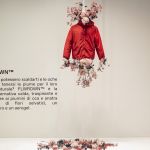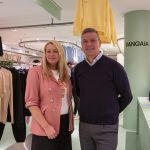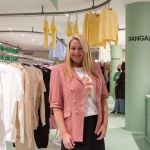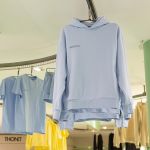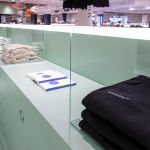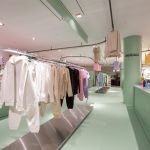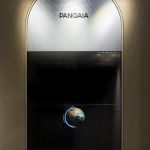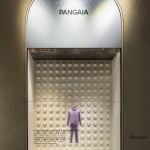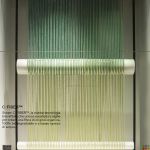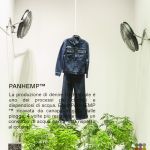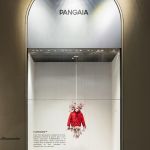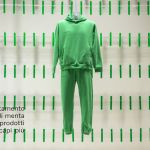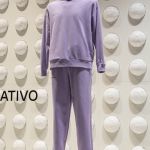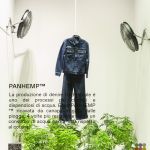
The future of Fashion according to Pangaia
The Fashion Scientist Amanda Parkes tells brands' vision that contamines Rinascente
February 24th, 2022
Pangaia began a huge success during the pandemic period but is much more than a brand of colored suits: the company encompasses an entire research and development sector, sells its materials to third parties and aims to combine the power of natural materials with research in the production of natural biopolymers to increase functionality and reduce environmental impact. Pangaia's take-over at la Rinascente represents a union of intentions that performs very well both at an aesthetic and environmental level, in the shop windows and on the -1 design floor. The elective affinity between the two realities is based on the responsible use of available environmental resources, innovative research in the technological field but above all the projection of a different future for fashion. Rinascent's CEO Pierluigi Cocchini says he is "proud to have been chosen as the first point of contact in the Italian market by a stellar example of sustainability and innovation", to which he has made available for the first time the AIR SNAKE installation by and Italian designer Aldo Cibic. Leading the way towards the future of innovative materials in fashion is Dr. Amanda Parkes, Chief Innovation Officer at Pangaia, a fashion scientist with tons of experience in the field who told us about Pangaia's present and future, as well as her journey to shape the world of fashion with her ideas and expertise.
Your role at Pangaia is an inspiration to women in the tech world. What does it mean to be a "Fashion Scientist" and how does one become one?
"It's important to me, thank you. Let's just say that mine is a path that I built for myself while I was studying. I've always been interested in science and technology, but also fashion and art, I did whatever I liked, studying Mechanical Engineering at Stanford where I also delved into Product Design, then I majored in Art and then moved to Venice where I studied Exhibition Design, worked at the Guggenheim Museum developing experience in informal science education in museums. Then at MIT I studied interactivity for physical spaces, digital technologies and the body, and that's where the fashion connection comes in: I worked in textile robotics for material technologies, and completed a PhD involving computer science. I entered the fashion world through the back door, and as I went along I learned how toxic and polluting the materials we were using in the production of materials were. Nearly 60% of textile fibers, even natural ones, are treated with toxic materials and the end customer doesn't know and has no way of knowing. I became a "fashion scientist" working on the bio-fabrication of technologies involved in photosynthesis focusing on the relationship between nature and technology."
What are Pangaia's founding values and what does "high-tech naturalism" mean?
"As a company concerned with the positive impact on planet earth and promoting a business model oriented towards minimal pollution, the concept of high-tech naturalism is mainly developed in the area of research and development and defines the commitment to use the natural qualities of materials already present in nature in combination with technological materials to increase their functionality. One of our pillars is to promote biodiversity in the supply-chain, moving away from the use of only organic cotton, towards the use of regenerated cotton and mixing natural fibers such as fruit fibers to create blends that offer other material options. This has led to the creation of PANHemp™, our organic cotton blended with hemp, C-FIBER™ our cotton-free alternative created by blending eucalyptus pulp and seaweed powder, and finally FLWRDWN™, which is an alternative to animal-derived materials and replaces goose feathers with a mix of dried flowers and natural biopolymers that are the result of more than 10 years of research. Another goal of ours in line with high-tech naturalism is to find solutions for the creation of collagen without the use of animal-derived materials, and to work constantly in the search for possible substitutes for responsible but functional fashion."
"I entered the fashion world through the back door, and as I went along I learned how toxic and polluting the materials we were using in the production of materials were. Almost 60% of textile fibers, even natural ones, are treated with toxic materials and the end customer doesn't know and has no way of knowing."
Your model is futuristic for many emerging brands: how expensive is it and is it possible to apply it at scale with other brands?
"Coming from a tech-company for Pangaia I reason together with my partners in terms of development for the future: our model is definitely expensive at the beginning, especially in the experimental phase, so we relied on an innovation fund initially. The development time and costs are substantial at first, but once you understand how the production processes work and the resources needed, the costs pay off. Our materials are a form of income for us because we offer them to third party companies, and we are also open to collaborate with innovative start-ups to implement a sustainable and innovative production with our parameters. Collaboration is fundamental for us, we work internally to build our future and that of the fashion industry.
In terms of communication, the brand has been very successful on social media thanks to the high aesthetic impact of the garments, how do you communicate your scientific values to your audience?
"The public is genuinely interested in the world and if you make information available to keep them curious they respond positively. We are aware that at the time of launch Pangaia was a cool lounge-wear brand when the world was smart-working at home, but without our ethical and innovative values we would not have been as successful. There are those who choose us for the pop colors and slowly get in touch with the scientific and innovative reality behind the garments they wear and fall in love with them, and also those who actively follow a sustainable lifestyle and feel represented by our products. For us it is important to talk about fashion giving the opportunity to deepen the issues of innovation of materials, especially on something that, like clothing, ultimately affects health because the skin, the most common organ is so in contact with clothing. Fashion becomes not only a concern for the environment but for the safety of human beings and their well-being. That's why in our site will soon launch Pangaia Lab, a section that I like to call "the post to be nerdy", where all descriptions will refer to the materials in a scientific and thorough way.
What is the future of fashion and its business models according to Pangaia?
Beyond our pillars and values of producing materials for responsible development and collaboration between brands, at Pangaia we are very inspired by Gen Z and Gen Alpha. The new shopping model that we are sure is the right way to go, goes towards shopping experiences away from consumption, like the one made in collaboration with Rinascente. Fast fashion is slowly dying and the new model is to buy less, but better. Vintage and rental is growing a lot in the U.S. and around the world. It's good because it's better for the planet based on reusing great materials and beautiful clothes that don't become polluting waste. It's not something that happens overnight and maybe Pangaia will come along in a couple of years. Our FLWRDWN™ coats would be perfect for the occasion.

























































.jpg)
.jpg)
.jpg)
.jpg)
.jpg)
.jpg)
.jpg)
.jpg)
.jpg)
.jpg)

.jpg)
.jpg)
.jpg)
.jpg)
.jpg)
.jpg)

